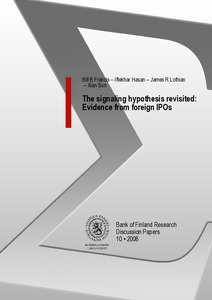The signalling hypothesis revisited : evidence from foreign IPOs
Francis, Bill B.; Hasan, Iftekhar; Lothian, James R.; Sun, Xian (01.04.2008)
Numero
10/2008Julkaisija
Suomen Pankki
2008
Julkaisun pysyvä osoite on
https://urn.fi/URN:NBN:fi:bof-20140807592Tiivistelmä
While the signalling hypothesis has played a prominent role as the economic rationale associated with the initial public offering (IPO) underpricing puzzle (Welch, 1989), the empirical evidence on it has been mixed at best (Jegadeesh, Weinstein and Welch, 1993; Michaely and Shaw, 1994). This paper revisits the issue from the vantage point of close to two decades of additional experience by examining a sample of foreign IPOs firms from both financially integrated and segmented markets in US markets. The evidence indicates that signalling does matter in determining IPO underpricing, especially for firms domiciled in countries with segmented markets, which as a result face higher information asymmetry and lack access to external capital markets. We find a significant positive and robust relationship between the degree of IPO underpricing and segmented-market firms seasoned equity offering activities. For firms from integrated markets, in contrast, the analyst-coverage-purchase hypothesis appears to matter more in explaining IPO underpricing and the aftermarket price appreciation explains these firms seasoned equity offering activities. The evidence, therefore, clearly supports the notion that some firms are willing to leave money on the table voluntarily to get a more favorable price at seasoned offerings when they are substantially wealth constrained, a prediction embedded in the signalling hypothesis.
Julkaisuhuomautus
Published in Journal of Financial and Quantitative Analysis, Volume 45, Issue 1, 2010: 81-106
